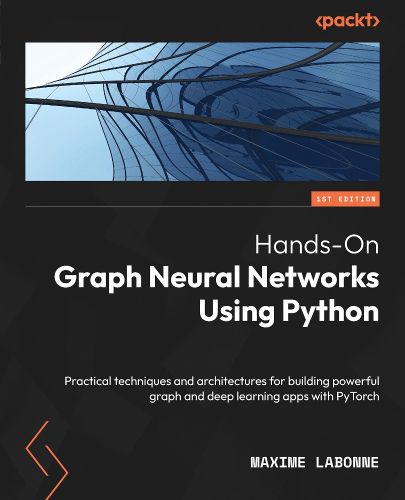Readings Newsletter
Become a Readings Member to make your shopping experience even easier.
Sign in or sign up for free!
You’re not far away from qualifying for FREE standard shipping within Australia
You’ve qualified for FREE standard shipping within Australia
The cart is loading…






This title is printed to order. This book may have been self-published. If so, we cannot guarantee the quality of the content. In the main most books will have gone through the editing process however some may not. We therefore suggest that you be aware of this before ordering this book. If in doubt check either the author or publisher’s details as we are unable to accept any returns unless they are faulty. Please contact us if you have any questions.
Design robust graph neural networks with PyTorch Geometric by combining graph theory and neural networks with the latest developments and apps Purchase of the print or Kindle book includes a free PDF eBook
Key Features
Implement -of-the-art graph neural architectures in Python Create your own graph datasets from tabular data Build powerful traffic forecasting, recommender systems, and anomaly detection applications
Book DescriptionGraph neural networks are a highly effective tool for analyzing data that can be represented as a graph, such as networks, chemical compounds, or transportation networks. The past few years have seen an explosion in the use of graph neural networks, with their application ranging from natural language processing and computer vision to recommendation systems and drug discovery. Hands-On Graph Neural Networks Using Python begins with the fundamentals of graph theory and shows you how to create graph datasets from tabular data. As you advance, you'll explore major graph neural network architectures and learn essential concepts such as graph convolution, self-attention, link prediction, and heterogeneous graphs. Finally, the book proposes applications to solve real-life problems, enabling you to build a professional portfolio. The code is readily available online and can be easily adapted to other datasets and apps. By the end of this book, you'll have learned to create graph datasets, implement graph neural networks using Python and PyTorch Geometric, and apply them to solve real-world problems, along with building and training graph neural network models for node and graph classification, link prediction, and much more.What you will learn
Understand the fundamental concepts of graph neural networks Implement graph neural networks using Python and PyTorch Geometric Classify nodes, graphs, and edges using millions of samples Predict and generate realistic graph topologies Combine heterogeneous sources to improve performance Forecast future events using topological information Apply graph neural networks to solve real-world problems
Who this book is forThis book is for machine learning practitioners and data scientists interested in learning about graph neural networks and their applications, as well as students looking for a comprehensive reference on this rapidly growing field. Whether you're new to graph neural networks or looking to take your knowledge to the next level, this book has something for you. Basic knowledge of machine learning and Python programming will help you get the most out of this book.
$9.00 standard shipping within Australia
FREE standard shipping within Australia for orders over $100.00
Express & International shipping calculated at checkout
This title is printed to order. This book may have been self-published. If so, we cannot guarantee the quality of the content. In the main most books will have gone through the editing process however some may not. We therefore suggest that you be aware of this before ordering this book. If in doubt check either the author or publisher’s details as we are unable to accept any returns unless they are faulty. Please contact us if you have any questions.
Design robust graph neural networks with PyTorch Geometric by combining graph theory and neural networks with the latest developments and apps Purchase of the print or Kindle book includes a free PDF eBook
Key Features
Implement -of-the-art graph neural architectures in Python Create your own graph datasets from tabular data Build powerful traffic forecasting, recommender systems, and anomaly detection applications
Book DescriptionGraph neural networks are a highly effective tool for analyzing data that can be represented as a graph, such as networks, chemical compounds, or transportation networks. The past few years have seen an explosion in the use of graph neural networks, with their application ranging from natural language processing and computer vision to recommendation systems and drug discovery. Hands-On Graph Neural Networks Using Python begins with the fundamentals of graph theory and shows you how to create graph datasets from tabular data. As you advance, you'll explore major graph neural network architectures and learn essential concepts such as graph convolution, self-attention, link prediction, and heterogeneous graphs. Finally, the book proposes applications to solve real-life problems, enabling you to build a professional portfolio. The code is readily available online and can be easily adapted to other datasets and apps. By the end of this book, you'll have learned to create graph datasets, implement graph neural networks using Python and PyTorch Geometric, and apply them to solve real-world problems, along with building and training graph neural network models for node and graph classification, link prediction, and much more.What you will learn
Understand the fundamental concepts of graph neural networks Implement graph neural networks using Python and PyTorch Geometric Classify nodes, graphs, and edges using millions of samples Predict and generate realistic graph topologies Combine heterogeneous sources to improve performance Forecast future events using topological information Apply graph neural networks to solve real-world problems
Who this book is forThis book is for machine learning practitioners and data scientists interested in learning about graph neural networks and their applications, as well as students looking for a comprehensive reference on this rapidly growing field. Whether you're new to graph neural networks or looking to take your knowledge to the next level, this book has something for you. Basic knowledge of machine learning and Python programming will help you get the most out of this book.